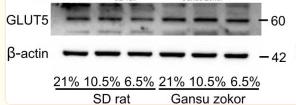GLUT5 Antibody - #DF13545
| Product: | GLUT5 Antibody |
| Catalog: | DF13545 |
| Description: | Rabbit polyclonal antibody to GLUT5 |
| Application: | WB IHC |
| Cited expt.: | WB |
| Reactivity: | Human, Mouse, Rat |
| Prediction: | Pig, Bovine, Horse, Dog |
| Mol.Wt.: | 50~70kDa; 55kD(Calculated). |
| Uniprot: | P22732 |
| RRID: | AB_2846564 |
Related Downloads
Protocols
Product Info
*The optimal dilutions should be determined by the end user. For optimal experimental results, antibody reuse is not recommended.
*Tips:
WB: For western blot detection of denatured protein samples. IHC: For immunohistochemical detection of paraffin sections (IHC-p) or frozen sections (IHC-f) of tissue samples. IF/ICC: For immunofluorescence detection of cell samples. ELISA(peptide): For ELISA detection of antigenic peptide.
Cite Format: Affinity Biosciences Cat# DF13545, RRID:AB_2846564.
Fold/Unfold
Facilitated glucose transporter member 5; Fructose transporter; Glucose transporte, kidney; Glucose Transporter 5 GLUT5; glucose transporter like protein 5; Glucose transporter type 5; Glucose transporter type 5 small intestine; GLUT 5; GLUT-5; GLUT5; GTR5_HUMAN; SLC 2A5; SLC2A5; small intestine; solute carrier family 2 (facilitated glucose/fructose transporter), member 5; Solute carrier family 2;
Immunogens
A synthesized peptide derived from human Glucose Transporter 5 GLUT5, corresponding to a region within N-terminal amino acids.
Detected in skeletal muscle, and in jejunum brush border membrane and basolateral membrane (at protein level) (PubMed:7619085). Expressed in small intestine, and at much lower levels in kidney, skeletal muscle, and adipose tissue.
- P22732 GTR5_HUMAN:
- Protein BLAST With
- NCBI/
- ExPASy/
- Uniprot
MEQQDQSMKEGRLTLVLALATLIAAFGSSFQYGYNVAAVNSPALLMQQFYNETYYGRTGEFMEDFPLTLLWSVTVSMFPFGGFIGSLLVGPLVNKFGRKGALLFNNIFSIVPAILMGCSRVATSFELIIISRLLVGICAGVSSNVVPMYLGELAPKNLRGALGVVPQLFITVGILVAQIFGLRNLLANVDGWPILLGLTGVPAALQLLLLPFFPESPRYLLIQKKDEAAAKKALQTLRGWDSVDREVAEIRQEDEAEKAAGFISVLKLFRMRSLRWQLLSIIVLMGGQQLSGVNAIYYYADQIYLSAGVPEEHVQYVTAGTGAVNVVMTFCAVFVVELLGRRLLLLLGFSICLIACCVLTAALALQDTVSWMPYISIVCVISYVIGHALGPSPIPALLITEIFLQSSRPSAFMVGGSVHWLSNFTVGLIFPFIQEGLGPYSFIVFAVICLLTTIYIFLIVPETKAKTFIEINQIFTKMNKVSEVYPEKEELKELPPVTSEQ
Predictions
Score>80(red) has high confidence and is suggested to be used for WB detection. *The prediction model is mainly based on the alignment of immunogen sequences, the results are for reference only, not as the basis of quality assurance.
High(score>80) Medium(80>score>50) Low(score<50) No confidence
Research Backgrounds
Functions as a fructose transporter that has only low activity with other monosaccharides. Can mediate the uptake of 2-deoxyglucose, but with low efficiency. Essential for fructose uptake in the small intestine (By similarity). Plays a role in the regulation of salt uptake and blood pressure in response to dietary fructose (By similarity). Required for the development of high blood pressure in response to high dietary fructose intake (By similarity).
Apical cell membrane>Multi-pass membrane protein. Cell membrane>Multi-pass membrane protein. Cell membrane>Sarcolemma.
Note: Localized on the apical membrane of jejunum villi, but also on lateral plasma membranes of the villi. Transport to the cell membrane is dependent on RAB11A.
Detected in skeletal muscle, and in jejunum brush border membrane and basolateral membrane (at protein level). Expressed in small intestine, and at much lower levels in kidney, skeletal muscle, and adipose tissue.
Belongs to the major facilitator superfamily. Sugar transporter (TC 2.A.1.1) family. Glucose transporter subfamily.
Research Fields
· Organismal Systems > Digestive system > Carbohydrate digestion and absorption.
References
Application: WB Species: Mice Sample: Hippocampal tissues
Application: WB Species: Rat Sample: brain tissues
Restrictive clause
Affinity Biosciences tests all products strictly. Citations are provided as a resource for additional applications that have not been validated by Affinity Biosciences. Please choose the appropriate format for each application and consult Materials and Methods sections for additional details about the use of any product in these publications.
For Research Use Only.
Not for use in diagnostic or therapeutic procedures. Not for resale. Not for distribution without written consent. Affinity Biosciences will not be held responsible for patent infringement or other violations that may occur with the use of our products. Affinity Biosciences, Affinity Biosciences Logo and all other trademarks are the property of Affinity Biosciences LTD.






